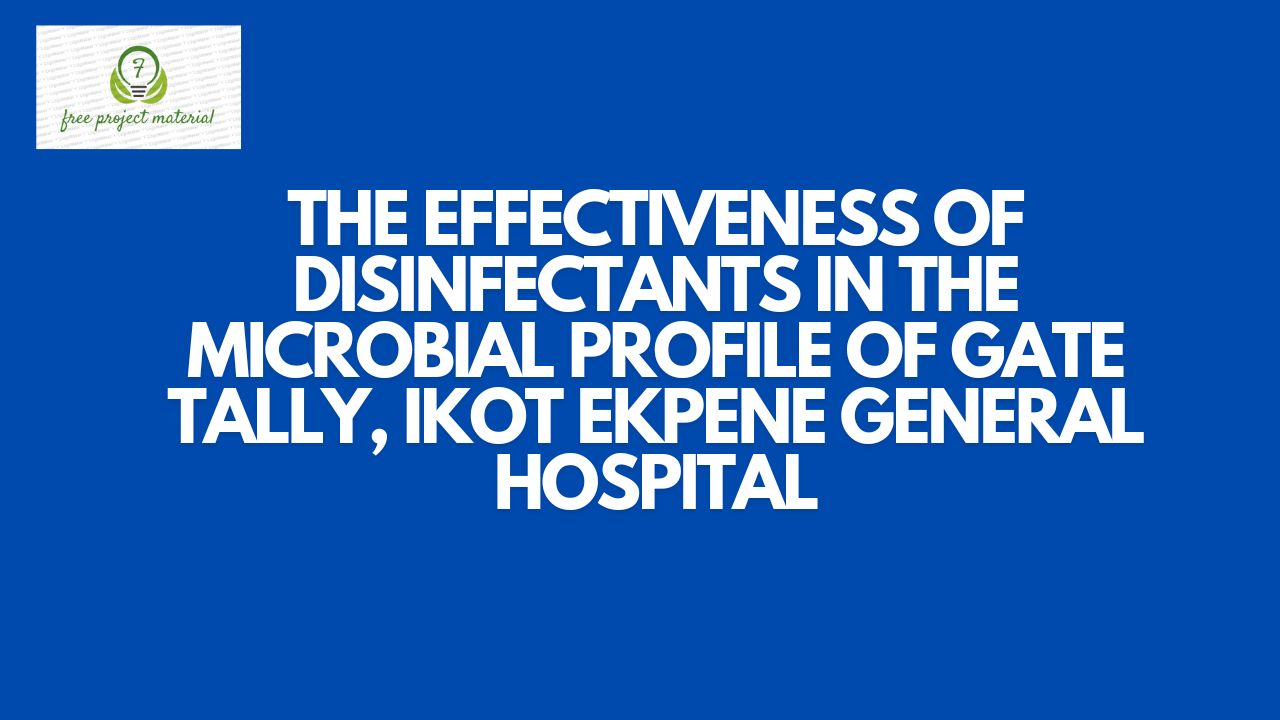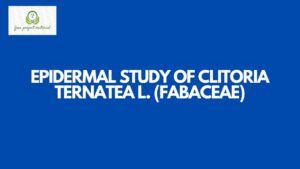ABSTRACT
The aim of this study was to examine the microbial profile of the gate tally of general hospital and to assess the effectiveness of different disinfectants on the bacterial isolates obtained. Standard aseptic procedures were employed in the collection of the samples and the microbial analysis of the samples collected. The result of this study revealed that one of the “OUT” tally cards had the highest heterotrophic bacterial colony counts; similarly, the one of the “OUT” tally also had the highest fungal colony count. The bacterial isolates obtained were; Staphylococcus sp., Escherichia sp., Bacillus sp. and Staphylococcus sp. while the fungal isolates were; Aspergillus sp., Mucor sp., Penicillium sp., Rhizopus sp. and Trichophyton sp.. Staphylococcus sp. had the highest frequency of occurrence (29.5%) while the least was Escherichia sp. (14.3%). The fungal isolates with highest and lowest percentage frequency of occurrence were Aspergillus (24.6%) and Rhizopus (10.5%). The wide array of this microbial contamination of the hospital gate tally reflects daily risk of exposure to several hospital acquired infections. Therefore, it is recommended that there should be regular disinfection of the gate-tally with appropriate disinfectant; furthermore, hand washing facility should be provided for visitors and staffs in strategic locations before exit of the hospital facilities.
TABLE OF CONTENTS
Title page – – – – – – – – i
Certification – – – – – – – ii
Dedication – – – – – – – – iii
Acknowledgements – – – – – – iv-v
Abstract – – – – – – – – vi
Table of contents – – – – – – – vii-viii
CHAPTER ONE: INTRODUCTION
1.1 Background of the study – – – – – – 1-3
1.2 Aim and Objectives – – – – – – 3
1.3 Scope and Limitation – – – – – – 3-4
CHAPTER TWO: LITERATURE REVIEW
2.1 Evidence of the role of surface in the transmission of
pathogenic microorganism – – – – – 5-6
2.2 Surface disinfection as part of a multi-barrier approach – 6-7
2.3 Efficacy testing for surface Disinfectants – – – 7-8
2.4 New and emerging applications of
surface disinfectants – – – – – – 8
2.4.1 Use of pre-soaked wipes – – – – – – 8-9
2.4.2 Terminal disinfection – – – – – – 9
2.5 Toxicity of biocides – – – – – – 9-10
2.6 Hospital infection – – – – – – – 11
2.6.1 Causes of infections in Hospital – – – – 11-12
2.6.2 Preventing Hospital Infection – – – – – 12-13
CHAPTER THREE: MATERIALS AND METHOD
3.1 Collection of glassware and media – – – – 14
3.2 Sterilization of glassware and media – – – – 14
3.3 Microbiological analysis – – – – – – 15
3.3.1 Cultivation of microorganism – – – – – 15
3.3.2 Enumeration of Bacterial Isolates – – – – 15
3.4 Purification of Bacterial Isolate – – – – – 16
3.5 Characterization and Identification of
Bacterial Isolates – – – – – – – 16-17
3.6 Characterization and Identification of Fungal Isolates – 17
CHAPTER FOUR: RESULT AND DISCUSSION
4.1 Result – – – – – – – – – 18-26
4.2 Discussion – – – – – – – – 27-33
CHAPTER FIVE: CONCLUSION AND RECOMMENDATION
5.1 Conclusion – – – – – – – – 34
5.2 Recommendation – – – – – – – 35
References
Appendix
CHAPTER ONE
INTRODUCTION
1.1 Background of the Study
Hospital environments are places that need more attention because of the influx of people coming for medical checkup and other services in the environment. Patients and hospital staff get in contact with this environment every day and some of these patients may have little or no knowledge about the bacteriology of the hospital air and various surfaces that are potential source of infections.
Most infections outbreak associated with inanimate objects are as a result of items that should be sterile, but have been contaminated by pathogens. These inanimate objects which have become contaminated by microorganisms, serves as a route of transmission of such organisms, they are called fomite, (Barriet et al., 1994). The outbreak of community acquired infections and nosocomial infections have been found to be aided by surface bio-contamination of fomites, (Nwankiti et al., 2012). Surface colonization of various inanimate objects in a hospital setting by microorganism has been reported as a potential vehicle for the transmission of nosocomial pathogens.
Hospital-acquired infections represent a serious public health problem in all countries. It is clear that monitoring of the hospital environment is an essential element in the control of nosocomial infections. The ability of microorganisms to survive on surfaces is due to their production of adhesion molecules and biofilms, (Cala et al., 2015). For a disinfectant to be effective, these factors should be considered, those inherent to the product, those inherent to the application and those inherent to the microorganisms. Product factors include concentration, formulation, water solubility and pH. Type of surface should also be considered.
Although imperfect, various strategies and bundled strategies have been shown to improve the clearing and disinfection of the hospital environment which is why there is need to discover disinfectant that is more potent in the eradication of microbial contaminant from surface of materials in the environment. Therefore, this study aimed at examining the effectiveness of disinfectants in the microbial profile of gate tally, a case study of General Hospital, Ikot Ekpene.
1.2 Aim and Objectives
The aim of this study is to examine the effectiveness of disinfectants on microbial profile of gate tally of General Hospital, Ikot Ekpene.
The objectives of this study are;
- To investigate the microbial profile of gate tally of General Hospital, Ikot Ekpene.
- To determine the sensitivity of the bacterial isolates to different disinfectants.
- To compare the microbial load of the Exit gate tally and the Entrance gate tally.
- To make recommendations based on the result of this study.
1.3 Scope and Limitation of the Study
This study only focuses on the microbial profile of the exit and entrance gate tally of the General Hospital, Ikot Ekpene and the effectiveness of three common disinfectants on the bacterial isolates obtain. This study was delimited due to time and financial constraints.


